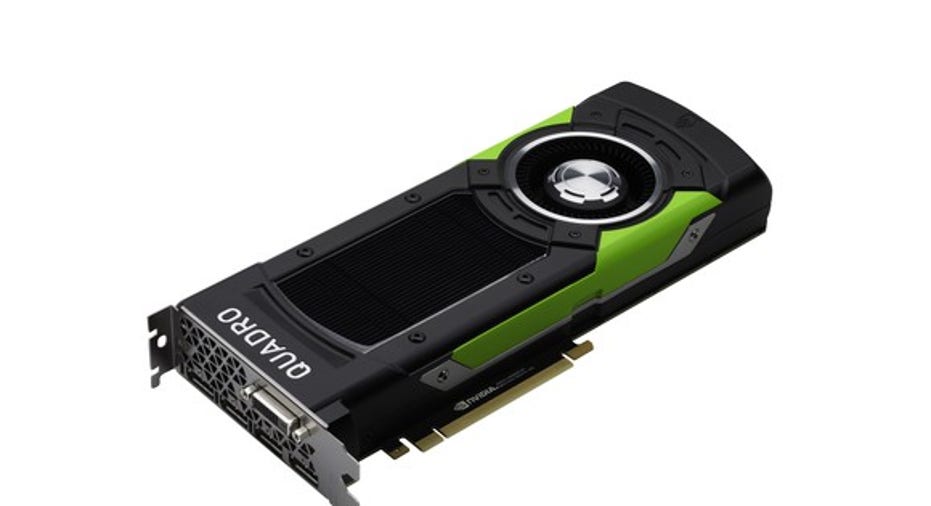Why Is NVIDIA Corporation's Titan X Using a Partially Disabled Chip?

Image source: NVIDIA.
When graphics specialist NVIDIA (NASDAQ: NVDA) announced its new Titan X graphics card, one thing that a lot of people noticed is that the card isn't using a fully enabled graphics processor. Indeed, the Titan X uses a chip with 3,584 graphics cores enabled out of a total of 3,840 on the chip, or about 93.3% of the total cores physically present on the chip enabled.
In a previous column, I speculated that the Titan X wasn't using a fully enabled variant of the GP102 chip because a fully enabled version, given the fixed power budget under which the card operates, just wouldn't be all that much faster than the partially disabled version.
Although this is likely true, it's worth pointing out that NVIDIA is selling fully enabled versions of GP102 as professional visualization products -- i.e., the Quadro P6000.
Although I still believe that for gaming a fully enabled GP102 chip would only be marginally better than the slightly disabled version, as the performance delta would likely be less than the 6.67% delta in core counts, there's another reason NVIDIA may be selling partially disabled chips as part of the Titan X.
A word on product segmentation
Investors should notice that NVIDIA reports revenue from "gaming" (i.e., GeForce GTX) separately from "professional visualization" (i.e., Quadro). Although the new Titan X isn't technically branded GeForce, the Titan X that I recently bought has the phrase "GeForce GTX" written in green LEDs on it, so I assume that for revenue recognition purposes, it is a GeForce gaming product.
At any rate, the Quadro and GeForce have historically been based on the same chips, with the main differences between them being software and firmware and, in some cases, on-board memory.
NVIDIA typically charges a lot more for Quadro products relative to their GeForce counterparts. For example, the previous generation Titan X sold for $999 to gamers, but the Quadro boards using the same exact chip retail for around $4,500.
It would seem that NVIDIA is saving the best chips for its highest-paying customers -- that is, those in professional visualization.
The rationale
There are two reasons I can see for NVIDIA's strategy of using the cut-down part for Titan X and the fully enabled part for Quadro P6000.
The first is the segmentation that I talked about. If NVIDIA delivers more value in a Quadro part relative to a similar GeForce part, then it might be able to widen the price delta between the top Quadro and top GeForce parts, ultimately boosting its Quadro average selling prices and potentially margins.
Beyond this, though, I suspect that manufacturing yields play a part in it. The GP102 chip is fairly large -- 471 square millimeters -- and is manufactured in Taiwan Semiconductor's (NYSE: TSM) relatively new 16-nanometer manufacturing technology.
Although I believe NVIDIA CEO Jen-Hsun Huang when he says 16-nanometer yields are "good," a 471-square-millimeter chip is a large chip, and there are bound to be quite a few chips that come off the line with slight imperfections.
Instead of throwing chips with a few imperfections into the trash heap and generating zero revenue from them, it makes more sense to sell them as part of $1,200 gaming graphics cards. Remember that even with some disabled functional units, the GP102 is dramatically faster than the GP104 chip that sells as part of $600-plus GeForce GTX 1080 graphics cards, so the company can command this premium.
So from a business perspective, this makes a lot of sense. NVIDIA sells the absolute best and most pristine GP102 chips as part of extremely expensive, high-margin workstation cards and then sells slightly less fast parts that are still extremely fast as expensive, high-margin gaming cards to gamers.
The only question that remains is whether NVIDIA will release a further cut-down part, likely as a GeForce GTX 1080 Ti, that's faster and more expensive than the GeForce GTX 1080 but slower and cheaper than the new Titan X.
A secret billion-dollar stock opportunity The world's biggest tech company forgot to show you something, but a few Wall Street analysts and the Fool didn't miss a beat: There's a small company that's powering their brand-new gadgets and the coming revolution in technology. And we think its stock price has nearly unlimited room to run for early in-the-know investors! To be one of them, just click here.
Ashraf Eassa has no position in any stocks mentioned. The Motley Fool owns shares of and recommends Nvidia. Try any of our Foolish newsletter services free for 30 days. We Fools may not all hold the same opinions, but we all believe that considering a diverse range of insights makes us better investors. The Motley Fool has a disclosure policy.



















